Describe your studio/work practice.
My curatorial practice is research-based. Accordingly, I don’t always work with artists when producing exhibitions. For a long time, I have been building archives and then activating them through exhibition-making, amongst other modes of presentation. In doing so, I seek to create space for subjects that have previously been overlooked. Generally speaking, I tend to use my curatorial projects as vehicles which not only enable, but also generate knowledge about the contexts that I work in. In my practice, I engage with oral histories and critical fabulation to account for absences in historical records. My research interests are expansive, ranging from socialist modernist art to grassroots manifestations that challenge dominant social and cultural narratives. The project for the Kosovo Pavilion, The Echoing Silences of Metal and Skin, engages with underrepresented histories of women in the workplace, confronting the consequences of precarious work conditions and how that has rendered women economically vulnerable and politically marginal.

What does participation in the Venice Biennale mean to you?
The history of Kosovo’s participation in the Venice Biennale is brief. In a span of ten years, Kosovo has been represented successfully through projects that dealt with identity politics, the 1999 Kosovo War, missing persons in Kosovo, and the way these experiences have been internationally mediatized. All these projects have resonated with one another and continue to have a major importance in weaving collective narratives. For the 60th edition of the Venice Biennale, Kosovo is showcasing an artist of the younger generation, Doruntina Kastrati, whose work deals with the condition of estrangement through investigation of counter-histories, first-person narratives, and experiences of marginalized groups. As a curator, realizing a project for the Kosovo Pavilion which makes visible narratives from the periphery of the skin and communicates from a critically-informed position is not only of paramount importance, but also a thematic shift from previous projects. This year we do not discuss war, but its aftermath. We are asking: What happens to women in unregulated economies whose only social capital is their labor? By doing so in a broader global context, we can initiate conversations that ripple far and wide.
What do you expect in terms of your career as a result of this participation?
I don’t think of curation as a career per se. Rather, I see it as one of the primary facets of my research practice. I am aware that this participation will bring a level of visibility to my work that I might not have had previously, and that this, in turn, could create new personal and professional opportunities. This being said, as a researcher, writer, and curator, I am—and will remain—committed to my long-time collaborators and the communities that I am a member of and learn from. This commitment has an ordering effect on my career goals. In my case, it means participating in meaningful conversations and having more interlocutors as we move forward to bring visibility to issues that matter.
Did you feel or sense anything during the application process or preparation that made you aware of being Central-Eastern European? If yes, what were the advantages or disadvantages of this? (eg.: financial aspect, reception)
Central-Eastern Europe is not a unified political space—it contains multitudes. Kosovo emerged from war a quarter century ago. The predominant narrative about our country remains war. When the international media covers Kosovo, it always reactivates this narrative thread. Even when artistic events of great importance take place locally, the contextual backbone is the legacy of the war. It has proven exceptionally difficult to free ourselves from this frame of representation. This complicates the work of developing a more textured understanding of Kosovo and its trajectory; further, it has structured how artists from Kosovo are perceived internationally, warping expectations of what they are capable of doing or discussing.
Do you think there is such a thing as ‘Central-Eastern European-ness’ in the field of fine arts, similar to history, politics, and culture? If yes, in what ways?
I see it as a political space with multiple art centers shaped by national cultures. But I don’t see it as a common space with ingrained similarities. Various political conceptions and imaginaries of Central-Eastern Europe across time have contributed to creating divisions and hierarchies of value among countries of this supposed geography, which is something that our generation has to pull apart and delegitimize as ways of knowing one another.
As a curator at the Venice Biennale, did you notice any changes in yourself during the preparation? E.g: Has your attention, taste, or opinion changed? Has your range of interests expanded? If yes, in what way?
The Echoing Silences of Metal and Skin is quite interdisciplinary. A wide range of people with different skill sets contributed to its development. Bringing together experts who will work with you for hours on end is a delicate exercise, which has to be managed with the utmost responsibility. For me, perhaps the most important skill was listening, as doing so helped me to navigate a complex and long-term production process, and to make the most of possibilities that I did not anticipate at the outset.
